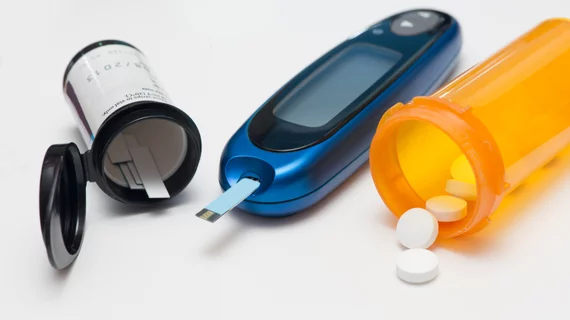Liraglutide was associated with a 10 percent reduction in major cardiovascular events for patients with type 2 diabetes in a real-world population, offering hope that the cardioprotective benefits observed in randomized trials translate to regular clinical practice.
The risk reduction was found among 23,402 patients who initiated treatment of liraglutide—a glucagon-like peptide-1 receptor agonist (GLP-1RA)—in Sweden or Denmark from 2010 through 2016. Patients were followed for an average of 3.3 years and compared to a propensity-matched cohort of an equal number of patients who were taking dipeptidyl peptidase-4 (DPP-4) inhibitors, other second-line glucose-lowering drugs prescribed in similar situations. Individuals in both groups were also taking metformin.
During follow-up, the primary composite outcome of stroke, MI or cardiovascular death occurred at a rate of 14 per 1,000 person years for liraglutide and 15.4 per 1,000 years for DPP-4 inhibitors. This corresponds to five fewer events per 1,000 patients treated with liraglutide over a three-year period.
“Although results from observational clinical effectiveness studies should be considered complementary, rather than comparable, to evidence from randomized trials, these findings suggest that the cardiovascular benefit of liraglutide seen in the LEADER trial might also be apparent in patients seen in routine clinical practice,” wrote lead author Henrik Svanström, PhD, and colleagues in The Lancet Diabetes & Endocrinology.
One notable aspect of the real-world population, the authors noted, is its mix of patients both with and without established cardiovascular disease. LEADER, on the other hand, only included patients with CVD or who were deemed at high cardiovascular risk, and they showed a 13 percent decline in heart attack, stroke and cardiovascular death compared to placebo.
In Svanström et al.’s study, diabetics with concurrent CVD experienced the greatest reduction in the primary endpoint with liraglutide—a 19 percent drop versus a 4 percent drop among those with no history of CVD.
Liraglutide was also linked to a 17 percent reduction in all-cause mortality and a 22 percent reduction in cardiovascular death, but had no significant effect in preventing MI, stroke or heart failure compared to DPP-4 inhibitors.
Svanström and coauthors said their work is the first large-scale study to analyze hard cardiovascular outcomes associated with liraglutide in routine practice. Patients older than 65 appeared to derive more benefit from the treatment, making it important to clarify in future trials whether the medication is also preventive in younger and lower-risk patients, two Austrian researchers wrote in an accompanying editorial.
“Overall, Svanström and colleagues' study provides encouraging new data confirming a cardiovascular benefit of liraglutide in a large and overall relatively low-risk population that is representative of everyday clinical practice,” wrote Guntram Schernthaner, MD, and Marie Helene Schernthaner-Reiter, MD, PhD. “Their results suggest the possibility of a cardiovascular benefit for all patients, with those at high cardiovascular risk seeming to derive the largest benefit.”
The research comes on the heels of a new expert consensus document released by the American College of Cardiology, which gave liraglutide the nod as the preferred GLP-1RA to reduce cardiovascular risk among patients with type 2 diabetes and atherosclerotic cardiovascular disease. That paper acknowledged certain GLP-1RAs and sodium-glucose cotransporter 2 inhibitors have directly improved cardiovascular outcomes, thrusting cardiologists into a more active role in prescribing these medications.

